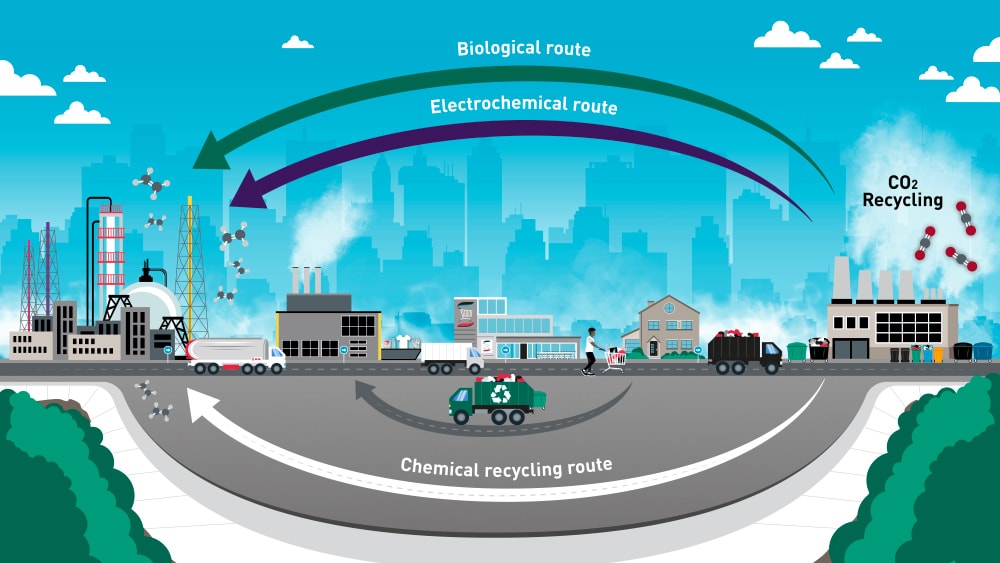About
The ambition of the Centre is to transform the UK’s £32 billion chemical industry into a future-proof, fossil-independent and environmentally friendly circular industry by developing sector-wide solutions for the efficient recycling and recovery of olefins and their complementary feedstocks. Olefins, such as ethylene and propylene, account for over 70% of all organic chemical production, used for the synthesis of a wide range of intermediate products, including polymers, chemical fibres, solvents, synthetic rubber and high-value speciality chemicals. These intermediates are subsequently used by other manufacturing and industrial sectors to produce useable end products.
Except for the limited mechanical recycling of a few selected chemical products, there is currently very little resource recovery from end-of-life materials, resulting in high volumes of waste putting significant strain on the environment. Current olefin production is almost exclusively based on fossil resources, consuming large amounts of energy and making a significant contribution to UK CO2 emissions. Disrupting these existing make-use-dispose models requires interventions and scientific innovations at all levels, starting from the development of new disruptive technologies (Theme 1), their integration into existing processes and evaluation of whole system impacts (Theme 2) to the identification of non-technical barriers and opportunities and how they can be overcome/realised (Theme 3).

The Centre comprises an interdisciplinary team of leading researchers from eight UK Universities, supported by over 20 industrial and international partners, perfectly placed to initiate this fundamental paradigm shift through its three interconnected research themes.
Research Programme
Theme 1 will develop key enabling technologies required to recovery olefins and their complementary feedstocks from end-of-life materials. There is no one-size-fits-all approach, and therefore we have identified several most promising routes with different TRLs which will be developed in parallel to achieve circularity. The solid waste route uses both existing pyrolysis/gasification approaches and emerging chemical recycling (hydrogenolysis) to convert currently non-recyclable materials (both municipal and industrial) into products such as short-chain hydrocarbons and syngas, which can be converted using existing processes to produce valuable olefin feedstocks. The captured CO2 route relies on electrochemical transformation of captured CO2 emission from industrial sources into olefin (either directly or indirectly), driven by renewable (off-peak) electricity. The biological route recycles waste biomass as feedstock, using integrated biological and thermochemical methods to produce CH4, H2 and biooils, with subsequent chemical transformation into viable products.
Theme 2 focuses on the integration of these technologies with existing processes and the optimisation of whole systems. Sustainability may only be assessed by means of a systems-wide approach, which combines techno-economic, environmental, and social impact indicators alongside circularity targets. Here, we need to go beyond individual technologies to understand how they can be combined and interact with each other and the existing infrastructures. To this aim, detailed process and supply-chain modelling embedded into advanced computational optimisation tools are required to identify pinch points across the whole value-chain, and enable optimal use of materials and energy via cascading and integration across processes within and beyond the clusters
Theme 3 will develop new forward-looking methodologies to overcome the non-technical challenges associated with such a radical change. We will work with government, businesses, the third sector and consumers to understand the opportunities, challenges, and deliver effective real-world solutions. Purpose-driven business and finance models that are socially, economically, and politically appropriate for the deployment of circular chemical economy need to be explored for multi-sector organisations of various sizes. Social dynamics need to be understood to design pathways for public acceptance of the new circular economy. We also need to pinpoint areas requiring government intervention. All above cannot be achieved without a rigorous knowledge co-creation among a wide range of stakeholders and users.
The CircularChem Video Series showcases our ten diverse research groups as they highlight their significant achievements, capabilities and aspirations for future funding and collaboration.